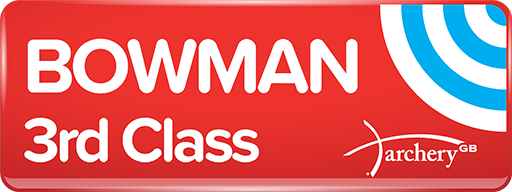(This article is aimed at novice archers. If you’re a club records officer who has to administer the system, there’s a more appropriate article here)
Just like the coloured belts in karate, the classification system in UK Archery represents a set of 9 milestones on an archer’s journey for beginner to master. Instead of belts, we have badges –
 |
 |
 |
 |
 |
 |
 |
 |
 |
At a high-level, the classification system is quite simple – you need to shoot a certain number of arrows, above a certain score threshold at appropriate qualifying events, in order to reach each classification level, and get that badge. This article will take a look at each of those three things.
Eligibility
As you might expect, the different classifications have different requirements placed on them in order to ensure the integrity and stature of the system. As you move up through the classifications, you are required to demonstrate the required level at different types of events. The lower classifications can be achieved in a club practice session, whereas the top-tier classifications can only be achieved at record status competitions.
Similarly, the amount you have to shoot also increases as you move up through the system. The lower tier classification can be achieved by shooting a few short rounds (or one longer one) whereas the top tier requires three times as much shooting to achieve.
This table summarises all of those rules, and shows system has 9 levels, split into three tiers of 3. The three tiers differ only in the eligibility rules attached to them, and different designs and colours of badges.
| Sub-Levels | Award Requirements | ||||
|---|---|---|---|---|---|
| From rounds totalling at least | Rounds | Type of event | Administered by | ||
| Archer Tier | Archer 3rd Class (A3) | 12 dozen arrows | All rounds of an appropriate distance | Any event | Clubs |
| Archer 2nd Class (A2) | |||||
| Archer 1st Class (A1) | |||||
| Bowman Tier | Bowman 3rd Class (B3) | 18 dozen arrows | Any competitive event | ||
| Bowman 2nd Class (B2) | |||||
| Bowman 1st Class (B1) | |||||
| Master Bowman Tier | Master Bowman (MB) | 36 dozen arrows | Age-appropriate rounds in the York/Hereford/Bristol, WA1440, and WA720 round families. | Any Record Status Competition | ArcheryGB |
| Grand Master Bowman (GMB) | |||||
| Elite Master Bowman (EMB) | |||||
The amount of shooting required is measured by the number of dozen arrows needed. This is a fairer way to do it rather than just shooting a fixed number of rounds because rounds can vary massively in size. For example, if someone shot a certain level on 3x 4-dozen Warwick rounds, that’s not as big an achievement as if they hit that same level on 3x 12-dozen 1440 rounds. Doing it this way does mean that you (or more precisely your club records officer) needs to keep track of how may dozen arrows you’ve shot at each level. There’s an example at the bottom of the page that shows how this works.
The Bowman tier classifications state that they should be shot at a “Competitive Event”, but that doesn’t necessarily mean a competition. Any club Target Day (as it’s defined in the Rules of Shooting), or any league match etc. also counts for this tier.
What Score Do I Need?
Now that we’ve established what sorts of events qualify and how much you need to shoot, the last question is how well do you need to shoot? What scores are required for each classification?
The answer lies in the official classification tables. These tables show, for any given category of archer, what scores are required on a particular round to qualify for a classification. All of these tables can be access on the ArcheryGB website, or here on the ArcheryGeekery site. There is one document for each bowstyle – recurve, compound, barebow, longbow. Those documents are useful for printing out (just the page that’s relevant to you), but are not great to use on a mobile device on the field. Tall, thin mobile-friendly tables are available here which are much better for that purpose.
As an example, this is the classification table for Recurve Under 18 Men –

Using these tables is simple. If this person was shooting a Bristol 1 round, and scored 850 points, we look across that row and see that this score is above the B2 level, but not quite at the B1 level. That means this score counts as a B2, as long as this was at a competitive event. If this score was shot in a club practice session, the highest possible classification would be A1.
Not all rounds can be used to achieve all classifications. The rules behind that are not necessary to understand in order to use the tables. If there is a score shown in a particular round for the archer’s category, then it can be used.
Some scores are highlighted in bold as being the ones that coaches agree are the appropriate level of challenge for archers of a particular age or ability, but any score listed can absolutely still be used if archers feel comfortable with them.
Worked Example
The easiest was to see this in action is with an example. The picture below shows the fictional season of an archer Men’s U18 Barebow archer. The coloured columns (i) are there to provide a graphical illustration of how the the number of qualifying arrows per classification evolves throughout the season. The bold coloured boxes show the points where the archer achieved the number (or greater) of arrows required at that tier for the next classification. This is just an illustration of what happens behind the scenes, and you don’t need to calculate these.
This example shows an archer who became remarkably good through the course of just one season, but it illustrates many aspects of the classification system quite well. For example, some of the scores didn’t qualify due to eligibility criteria and were downgraded. Column (d) indicates what type of event it was, with non-competitive rounds maxing out at Archer 1st Class, non-record status competitive events maxing out at Bowman 1st Class, and record status events letting you go all the way. Each score has it’s own classification, shown in column (f) and the archer’s current rolling classification is shown in column (g).

That table can be viewed in conjunction with this image of the classification table, with each round from column (a) above highlighted on it.

Classification Lifetimes
Classifications last until the end of the next season. An outdoor classification gained in the 2023 will persist until the end of the 2024 outdoor season. If you don’t reacquire it (or better it) you lose that one and would be awarded a classification based on solely on the scores from that 2024 season. If you haven’t shot enough to get a new classification, you revert to an “Unclassified” status until you gain a new classification.
So, at the start of each season, the records officer will check whether your classification has expired, and if so will calculate your new classification based on the scores you did shoot.
The same procedure applies when a junior moves up an age group – their scores from the previous season are assessed against the new age-group’s classification table to calculate the new classification, or to assign them as Unclassified if sufficient scores weren’t shot.
Summary
Much of the work of figuring out what your classification is is done by your club’s Records Officer. As an archer, you need to –
- Find the correct classification table for your category so that you know what scores you need to shoot, and what rounds will let you achieve your next classification.
- Find appropriate events that let you achieve the tier of classification that you’re chasing.
- Submit scores to you club records officer to validate your claims, or to ArcheryGB for Master-tier awards.
- Wear your new badges with pride!
Next part in the series: Indoor Classifications
Leave a Reply